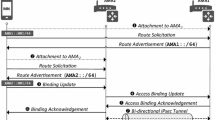Abstract
This paper evaluates the performance overheads of two Host Identity Protocol-based signalling schemes controlling internet protocol connectivity establishment and handover procedures in distributed mobile networks. The paper proves using an analytical model that the Ultra Flat Architecture has significant performance gains on user side, in the access networks and at the rendezvous service over the terminal-based architecture due to the application of delegation of signalling rights. On the other hand, the former architecture results in greater overhead in the transport network connecting the gateways and at the gateways. The results also provide guidance on the optimal setting of protocol lifetime parameters, maximum delegation authorization certificate chain length and distribution level of gateways in both schemes.


























Similar content being viewed by others
References
Cisco. (2014). Cisco visual networking index: Global mobile data traffic forecast update, 2013–2018. White Paper.
Daoud, K., Herbelin, P., & Crespi, N. (2008). UFA: Ultra Flat Architecture for high bitrate services in mobile networks. In Proceedings of the IEEE 19th international Symposium on personal, indoor and mobile radio communications (PIMRC), Cannes, France. doi:10.1109/PIMRC.2008.4699577.
Faigl, Z., Bokor, L., Neves, P., Daoud, K., & Herbelin, P. (2011). Evaluation of two integrated signalling schemes for the Ultra Flat Architecture using SIP, IEEE 802.21, and HIP/PMIP protocols. Computer Networks, 55(7), 1560–1575.
Bokor, L., Faigl, Z., & Imre, S. (2010). A delegation-based HIP signaling scheme for the ultra flat architecture. In Proceedings of the 2nd international workshop on security and communication networks (IWSCN’10), Karlstad, Sweden. doi:10.1109/IWSCN.2010.5498001.
Nikander, P., Gurtov, A., & Henderson, T. (2010). Host identity protocol (HIP): Connectivity, mobility, multi-homing, security, and privacy over IPv4 and IPv6 networks. IEEE Communications Surveys & Tutorials, 12(2), 186–204.
Jokela, P., Moskowitz, R., & Nikander, P. (2008). Using the encapsulating security payload (ESP) transport format with the host identity protocol (HIP). IETF RFC 5202.
Moskowitz, R., et al. (2008). Host identity protocol. IETF RFC 5201.
IEEE. (2009). IEEE standard for local and metropolitan area networks—part 21: Media independent handover. IEEE Std 802.21-2008.
Moskowitz, R. (2012). HIP Diet EXchange (DEX). IETF Draft, draft-moskowitz-hip-rg-dex-06.
Faigl, Z., Bokor, L., Pellikka, J., & Gurtov, A. (2013). Suitability analysis of existing and new authentication methods for future 3GPP Evolved Packet Core. Computer Networks, 57(17), 3370–3388.
Faigl, Z., & Telek, M. (2014). Modeling the signaling overhead in host identity protocol-based secure mobile architectures. Journal of Industrial and Management Optimization (JIMO) (in press).
3GPP. (2012). Security Aspects of non-3GPP Accesses (Release 11). 3GPP TS 33.402.
Loughney, J., Nakhjiri, M., Perkins, C., & Koodli, R. (2005). Context transfer protocol (CXTP). IETF RFC 4067.
Nikander, P., & Arkko, J. (2004). Delegation of signalling rights. In B. Christianson, B. Crispo, J. A. Malcolm, & M. Roe, (Eds.), Security protocols, Springer lecture notes in computer science, (Vol. 2845, pp. 575–586).
Herborn, S., Huber, A., Boreli, R., & Seneviratne, A. (2007). Secure host identity delegation for mobility. In Proceedings of the 2nd international conference on communication systems software and middleware (COMSWARE), Bangalore, India. doi:10.1109/COMSWA.2007.382596.
Allard, F., & Bonnin, J.-M. (2008). An application of the context transfer protocol: IPsec in a IPv6 mobility environment. International Journal of Communication Networks and Distributed Systems, 1(1), 110–126.
Allard, F., et al. (2008). Security analysis and security optimizations for the context transfer protocol. In Proceedings of the 2nd IFIP international conference on new technologies, mobility and security (NTMS), Tangier, Morocco. doi:10.1109/NTMS.2008.ECP.87.
Allard, F., et al. (2008). IKE context transfer in an IPv6 mobility environment. In Proceedings of the 3rd international workshop on mobility in the evolving onternet architecture (MobiArch). doi:10.1145/1403007.1403020.
Almesberger, W. (2004). TCP connection passing. In Proceedings of the linux symposium, Ottawa, Canada (Vol. 1, pp. 1–13).
Farahbakhsh, R., & Movahhedinia, N. (2008). Using context transfer mechanisms to Improve Mobile IMS-IPv6 Handover Latency and QoS provisioning. In Proceedings of the 2nd international conference on internet multimedia services architecture and applications (IMSAA), Bangalore, India. doi:10.1109/IMSAA.2008.4753926.
Faigl, Z., Pellikka, J., Bokor, L., & Gurtov, A. (2014). Performance evaluation of current and emerging authentication schemes for future 3GPP network architectures. Computer Networks, 60, 60–74.
Kivinen, T., & Kojo, M. (2003). More modular exponential (MODP) Diffie–Hellman groups for internet key exchange (IKE). IETF RFC 3526.
Rivest, R., Shamir, A., & Adleman, L. (1978). A Method for obtaining digital signatures and public-key cryptosystems. Communications of the ACM, 21(2), 120–126.
Heer, T., & Varjonen, S. (2011). Host identity protocol certificates. IETF RFC 6253.
Laganier, J., Koponen, T., & Eggert, L. (2008). Host identity protocol (HIP) registration extension. IETF RFC 5203.
Nikander, P., Henderson, T., Vogt, C., & Arkko, J. (2008). End-host mobility and multihoming with the host identity protocol. IETF RFC 5206.
Kulkarni, V. G. (1995). Modeling and analysis of stochastic systems. London: Chapman & Hall Ltd.
Nir, Y. (2006). Repeated authentication in internet key exchange (IKEv2) protocol. IETF RFC 4478.
Acknowledgments
This work has been carried out in the framework of CELTIC-Plus Project CP2012/2-5 SIGMONA and supported by the “Virtualization-based Mobile Network Optimization” Project of the Hungarian National Development Agency (EUREKA HU 12-1-2012-0054). The author would like to acknowledge the contributions of his colleagues, although the views expressed are those of the author and do not necessarily represent the project. This information reflects the consortium’s view, but the consortium is not liable for any use that may be made of any of the information contained therein.
Author information
Authors and Affiliations
Corresponding author
Rights and permissions
About this article
Cite this article
Faigl, Z. Performance analysis of signalling overhead in Host Identity Protocol-based secure mobile networks: Ultra Flat Architecture or end-to-end signalling?. Wireless Netw 21, 531–555 (2015). https://doi.org/10.1007/s11276-014-0797-8
Published:
Issue Date:
DOI: https://doi.org/10.1007/s11276-014-0797-8




